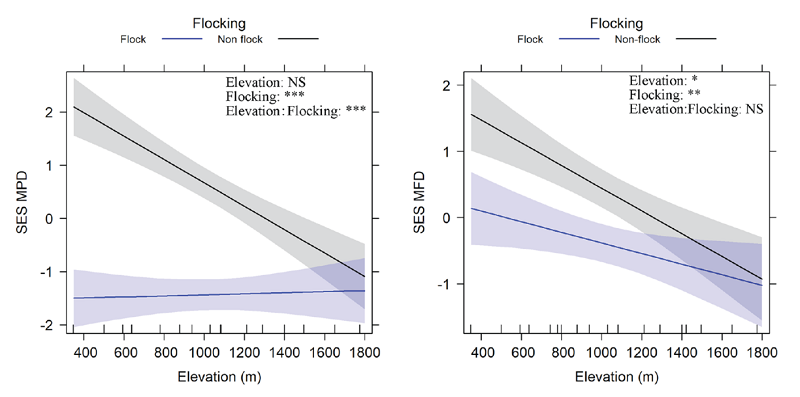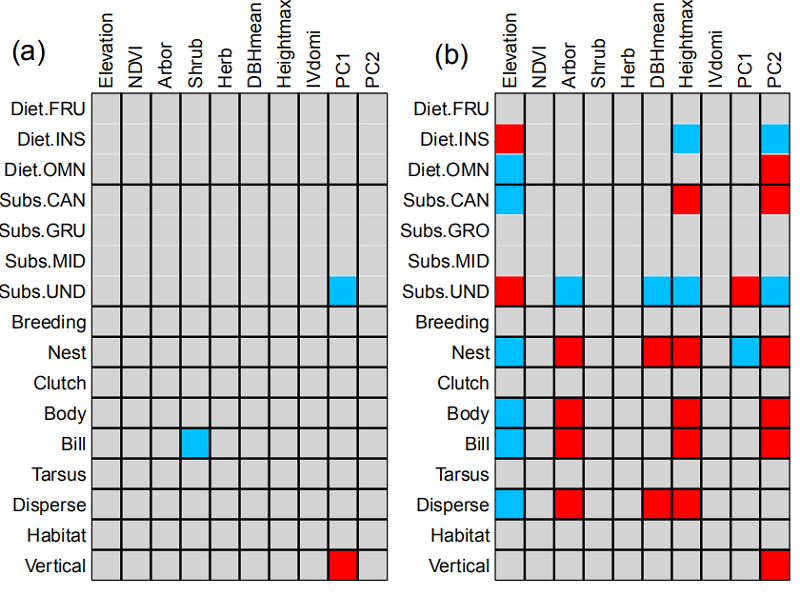The Institute of Zoology, Guangdong Academy of Sciences unveiled the community assembly mechanisms of birds in the Nanling Mountain
Date:2021-02-02
Mixed-species bird flocks (MSF) are defined as “groups of two or more species that move and forage together”. MSFs are widely acknowledged to increase predator avoidance and foraging efficiency, and thereby increase participants’ fitness, which were often used to investigate community structure of birds. The mechanisms of community assembly suggest that biotic and abiotic filters constrain species establishment through selection on their functional traits, but it is unclear how differences in traits influence the niche dimensions of closely related bird species when they coexist in spatiotemporally heterogeneous environments.
Prof. Qiang Zhang’s group at Institute of Zoology, Guangdong Academy of Sciences, conducted counts of forest bird species and took measurements of environmental variables along an elevational gradient for six years in the Nanling Mountains, China. In order to disentangle different deterministic and historical/stochastic processes between flocking and non-flocking bird assemblages, researchers compared phylogenetic and functional structure, and community-weighted mean trait values (CWM), and assessed elevational variations in trait-environment relationships.
Results presented that the flocking and non-flocking bird assemblages were structured by environmental gradients in contrasting ways. The non-flocking assemblage showed a strong change from over-dispersed to clustered community structure with increasing elevations, consistent with the strong selective pressures of a harsh environment (i.e., environmental filtering) (Fig. 1). The non-flocking assemblage also displayed significant trait–environment relationships in bivariate correlations and multivariate ordination space, including specific morphological and foraging traits that are linked to vegetation characteristics (e.g., short trees at high elevations). By contrast, flocking birds were more resilient to habitat change with elevation, with relatively consistent community membership, and showed fewer trait-environment associations (Fig. 2). CWM of traits that are known to be associated with species’ propensity to join mixed-species flocks, including small body size and broad habitat specificity, were linked to the flocking assemblage consistently across the elevational gradient.
This study provides a strong evidence that trait-environment relationships differ between flocking and non-flocking bird assemblages. Besides serving as bellwethers of changing environments, emergent properties of flock systems may increase the resilience of animal communities undergoing environmental change. Mixed-species flocks present an ideal model with which to explore cooccurrence of closely related species, because habitat filtering may be buffered, and the patterns observed are therefore the outcomes of species interactions including both competition and facilitation.
The above findings from Prof. Qiang Zhang’s group were published in Ecology, entitled "Trait-environment relationships differ between mixed-species flocking and non-flocking bird assemblages”.
Link to the article: https://doi.org/10.1002/ecy.3124

Fig. 1 General linear modeling with the response variable of standardized effect size of the mean pairwise distance based on phylogeny (SES.MPD) and multiple functional traits (SES.MFD).

Fig. 2 The bivariate fourth-corner tests showing the relationship between environmental variables and functional traits of (a) flocking and (b) non-flocking bird assemblages.

